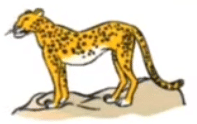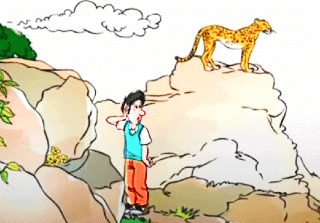Detailed Summary: No Room for Leopard | English Reader New Gems Class 6 PDF Download
| Table of contents |

|
| Key Points |

|
| Detailed Summary |

|
| Theme/ Message |

|
| Difficult Words |

|
Key Points
- The narrator describes his love for nature and how he enjoys exploring a lush valley near his cottage.
- He first encounters a leopard while crossing a stream and observes the wildlife that thrives in the area.
- The narrator realizes that the animals, including the langurs and deer, have become accustomed to his presence because he does not disturb them.
- One day, he sees a beautiful orange-gold leopard that seems puzzled by his presence, indicating a mutual understanding between them.
- Despite the tranquility of the valley, the narrator learns that hunters are in the area searching for the leopard, which causes him concern.
- He discovers a dead barking deer, indicating that the leopard has been hunting in the area.
- During his explorations, he comes across the ruins of an old settlement and senses the presence of the leopard nearby.
- The narrator feels a connection with the leopard and values the trust that has developed between them.
- Tragically, the peace of the valley is shattered when hunters kill the leopard, which the narrator mourns deeply.
- In the end, the narrator reflects on the loss and recalls a poem that emphasizes the coexistence of humans and wild animals.
Detailed Summary
This story talks about how the author loves nature and how he feels a special connection with the animals around him, especially a leopard that lives nearby. The story shows us how nature can be beautiful and peaceful, but sometimes it can also be dangerous or sad. Let's explore the story step by step, using simple words to help us understand everything that happens.
The author begins by telling us about the first time he saw the leopard. He was walking near a small stream at the bottom of a hill. This place was special because it had a deep ravine where it was dark for most of the day. Because it was shady, many birds and animals liked to come out during the daytime. People rarely walked in that area, so it became a safe home for many creatures.

Below where the author lived, there was a beautiful forest filled with tall oak and maple trees, as well as bright rhododendron flowers. A narrow path went down through the trees, leading to a grassy area surrounded by wild dog-roses. Close to this grassy area, there was a stream that flowed over smooth pebbles, making a soft, soothing sound.
Every morning, the author would hear the barking deer calling out. He saw pine martens and a lovely red fox. He also found bear footprints, which made him feel excited. The author was careful not to disturb the animals because he did not come to take anything from the jungle. Because of this, the birds and animals got used to him being around. Over time, they learned that he was not a threat, and they started to accept him as part of their world.
The langurs, which are a type of monkey, used to jump around in the trees when they saw the author. However, as they got used to him, they began to watch him curiously while they ate the fresh green shoots of the oak trees.
One evening, while passing by, the author noticed that the langurs were making noise. They were not excited because of him, but it seemed like they were warning him about something dangerous nearby. Suddenly, a shower of pebbles rolled down the steep hill. The author looked up and saw the beautiful orange-gold leopard sitting on a rock about twenty feet above him. The leopard was focused on something in the ravine, not paying attention to the author at first. When the leopard finally noticed him, it looked a bit puzzled, as if it didn't understand why he was there.
To show that he was not a threat, the author clapped his hands. This startled the leopard, and it quickly disappeared into the bushes without making a sound. Although he had frightened the leopard, the author could hear the sound of a barking deer running away, which meant the leopard was still hunting for food.
The author mentioned that leopards are becoming very rare in India, so he was surprised to see one so close to where he lived in Mussoorie. He thought that the deforestation, or cutting down of trees, in the surrounding hills had scared the deer into the green valley where he was living.

Although the author did not see the leopard again for several weeks, he often felt that it was nearby. Sometimes, he felt as if he was being followed. Once, when he was late returning home, he saw two bright eyes staring at him from the bushes. His heart raced, but then he realized that the eyes belonged to fireflies, not the leopard.
As the weather got hotter in May and June, the hills became dry, but the area near the stream remained cool and green. One day, the author discovered the remains of a barking deer that the leopard had partially eaten. He wondered why the leopard had not hidden the leftover food. Perhaps it had been interrupted while eating.
While climbing the hill, the author met a group of hunters resting under the oak trees. They asked him if he had seen the leopard, and he said no. The hunters claimed they knew there was a leopard in the forest because they had found the deer carcass and the leopard's footprints. They often came to the forest to hunt, and almost every evening, the author could hear their guns firing at different animals.
The hunters warned the author about the leopard, telling him he should carry a gun for protection. However, the author did not have a gun and preferred to avoid the hunters because he found them unpredictable. As time passed, he noticed that there were fewer birds in the area and even the langurs had left.
One day, the author decided to climb a steep hill called Pari Tibba, which was covered with scrub and had no people living there. It was a tough climb because there was no clear path, and he had to use rocks and roots to help him. When he finally reached the top, he found a flat area with some pine trees. The trees swayed gently in the wind, making a soft humming sound. There, he discovered the ruins of what used to be the first settlers' homes; now, they were just piles of stones covered with weeds, dandelions, and nettles.
As the author walked through the old ruins, he felt a deep silence all around him. It was so quiet that it almost felt like the silence was shouting in his ears. But there was something else he noticed—a strong smell that reminded him of a big cat. He stopped and looked around, realizing he was alone, with no movement around him. The ruins were mostly open to the sky, and he saw that the rafters had fallen down, creating a dark passage like the entrance to a cave. The smell was stronger as he got closer to this dark spot, and he wondered if it could be the leopard's home. He imagined that the leopard might be resting there after a night of hunting, watching him quietly, recognizing that he was a friend who walked in the forest without any weapons.
Not wanting to disturb the leopard, the author decided not to go further into the ruins. Instead, he cherished the feeling that the leopard trusted him. However, he also worried if this trust would be broken by others.
The next day, as he came back from the stream, the author heard shouting and drumming sounds. It was the hunters again. They were carrying a long bamboo pole on their shoulders, and hanging from it was the lifeless body of the leopard. It had been shot in the neck and head. The hunters seemed very happy and shouted, "We told you there was a leopard! Look at this beautiful creature we got!"
The author felt a deep sadness. He agreed with them that the leopard was indeed beautiful, but his heart was heavy. He walked home through the quiet forest, feeling that something important had been lost. It was so silent, almost as if the birds and animals felt the sadness too, knowing that their trust had been broken by the hunters.
As he climbed the steep path to his home, the author remembered some words from a poem by D.H. Lawrence. The lines echoed in his mind, saying that there was enough space in the world for a mountain lion and himself. This thought made him reflect on the importance of living together with all creatures in nature, respecting their space and life.
In summary, this story beautifully shows the relationship between humans and nature. It highlights the author's love and admiration for the leopard and the natural world, but it also reminds us of the dangers that threaten wildlife. The tragic ending, where the leopard is killed by hunters, serves as a powerful reminder of the need to protect and respect all living beings.
Theme/ Message
- The main theme of the story is the beauty of nature and the bond between humans and animals. The narrator's admiration for the leopard represents a deeper understanding of wildlife.
- The story also highlights the impact of human actions on nature, particularly through hunting and deforestation, which threaten the existence of animals like the leopard.
- Another important message is about trust and respect. The narrator learns to respect the animals and gains their trust, which is ultimately betrayed by the hunters.
- The tale serves as a reminder of the fragility of life and the importance of preserving natural habitats for future generations.
Difficult Words
- Admiration: A feeling of respect and approval for someone or something.
- Encounters: Meetings or experiences with someone or something.
- Mutual: Shared by two or more parties.
- Ravine: A deep, narrow valley with steep sides.
- Acustomed: Familiar or used to something through repeated experience.
- Chattering: Talking rapidly or excitedly.
- Puzzled: Confused or unable to understand something.
- Deforestation: The process of clearing forests or trees, often to make way for agriculture or development.
- Carcass: The dead body of an animal.
- Specimen: An example of something, often used in scientific contexts.
- Violated: Broken or disregarded a law, rule, or trust.
- Echoed: Repeated or reverberated, often used in the context of sounds.
- Unpredictable: Not able to be predicted or foreseen.
- Feline: Relating to cats or the cat family.
- Crouched: To bend down low, often to hide or prepare to spring up.
|
69 videos|283 docs|61 tests
|
FAQs on Detailed Summary: No Room for Leopard - English Reader New Gems Class 6
| 1. What is the main theme of "No Room for Leopard"? |  |
| 2. What message does the story convey regarding wildlife conservation? |  |
| 3. Who are the main characters in "No Room for Leopard"? |  |
| 4. What are some difficult words found in the text, and what do they mean? |  |
| 5. How does the story of "No Room for Leopard" relate to real-life issues? |  |



















